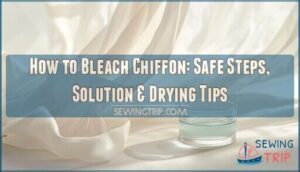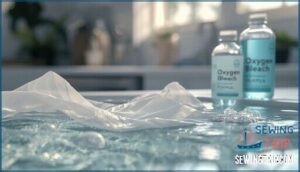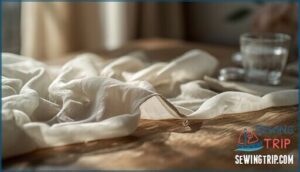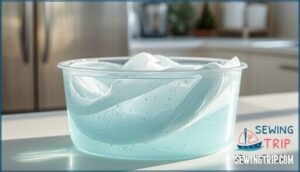This site is supported by our readers. We may earn a commission, at no cost to you, if you purchase through links.

The secret lies in understanding your fabric’s composition and using oxygen-based solutions that lighten without destroying the material’s signature drape.
With the right approach, you can safely fade or brighten chiffon while keeping its weightless texture intact.
Table Of Contents
Key Takeaways
- Oxygen-based bleach (hydrogen peroxide or sodium percarbonate at 1–3% concentration) is the only safe option for chiffon, as chlorine bleach instantly dissolves silk fibers and weakens polyester by over 30%.
- Always conduct a fabric test on a hidden seam with a 1:5 bleach-to-water ratio for 10 minutes before treating the entire garment, since polyester and silk chiffon react differently to oxidation.
- Keep soaking time between 5–10 minutes max in 60–80°F water with continuous gentle swirling to prevent brittleness and ensure even color discharge across the fabric.
- Immediately neutralize residual bleach with three cold-water rinses followed by sodium metabisulphite solution or distilled white vinegar to prevent ongoing oxidation that reduces tensile strength by 15% over time.
Can Chiffon Be Bleached?
Bleaching chiffon isn’t a risk-free move—your fabric’s survival depends entirely on what it’s made of. Polyester chiffon resists chlorine bleach but won’t release its dyes, while silk chiffon can literally dissolve under oxidation due to peptide bond breakdown. Chlorine-based bleaches destroy both fiber types through chemical reactions that weaken tensile strength by up to 25%.
Bleaching chiffon is risky—polyester resists chlorine but holds dye, while silk dissolves under oxidation, and both lose up to 25% tensile strength
That’s why bleach alternatives like oxygen-based products (hydrogen peroxide or sodium percarbonate) matter—they react 50% slower and preserve fabric integrity. Before attempting any delicate fabric bleaching, check your care label and conduct a hidden-area test. For color preservation and preventing irreversible fabric damage, oxygen bleach is your safest bet.
When dealing with valuable pieces, professional cleaning beats DIY chiffon fabric care every time. Using an eco friendly cleaner can also help in maintaining the fabric’s quality and safety.
Preparing The Bleaching Solution
Before you start mixing bleach with abandon, you need the right formula and a safety net. The wrong bleach or an untested approach can wreck your chiffon in seconds.
Here’s how to prep your solution without turning your fabric into confetti.
Choosing The Right Bleach
Your choice of bleach determines whether you’ll salvage your chiffon or ruin it—this isn’t the moment to wing it. Oxygen bleach, containing sodium percarbonate or hydrogen peroxide at 1–3% concentration, offers your safest path forward. Chlorine bleach destroys silk fibers instantly and weakens polyester by over 30%, making it your enemy here.
- Oxygen bleach: Maintains fabric integrity above 95% while working slower than chlorine alternatives
- Bleach concentration: Keep hydrogen peroxide solutions below 10% to prevent filament distortion
- Environmental impact: Oxygen-based options produce 70% lower chemical oxygen demand in wastewater
- Color preservation: pH-balanced formulas between 7.0–8.0 brighten without structural damage.
When working with delicate fabrics like chiffon, it’s necessary to follow proper delicate fabric care techniques to maintain their quality and longevity.
Conducting a Fabric Test
Skip the guesswork—your fabric test is the only checkpoint that stands between success and a ruined garment. Mix one part oxygen bleach with five parts cold water, then apply a single drop to a hidden seam or hem fold. Wait ten minutes and inspect for fiber weakening, color bleeding, or unexpected whitening under good lighting. Polyester chiffon usually shows minimal change, while silk often reveals damage through discoloration or texture shift.
| Test Parameter | What to Check |
|---|---|
| Color Change | Whitening, fading, or uneven lightness after 10 minutes |
| Fiber Integrity | Weakening, fraying, or surface roughness in the test area |
| Bleach Resistance | Material safety confirmed when visual changes stay under 5% |
Neutralize the spot with cold water immediately after testing to halt ongoing oxidation that could reduce fabric elasticity by 22% within a day.
Soaking The Chiffon
Once your bleach solution is ready and your test spot has passed inspection, it’s time to commit. This is where precision meets nerve—you’re in control, but only if you follow the protocol.
Lower your chiffon into the solution gently, making sure it’s fully submerged. Aim for a 1:10 bleach concentration if you want gradual fading without fiber compromise. Keep the water temperature between 60–80°F to slow the reaction and give you better control over tonal shifts. Set a timer for 5 to 10 minutes max—anything beyond that doubles brittleness in synthetic fibers. Swirl the fabric continuously to help uniform color discharge and cut patch variance by up to 30%. Watch closely after the first 2 minutes; reactions plateau around 8 to 10 minutes, so don’t zone out.
- Bleach concentration: Stick to a 1:10 ratio for safer, gradual fading on delicate fabrics
- Soaking time: Never exceed 10 minutes to avoid persistent stiffness or brittleness
- Water temperature: Use cool water (60–80°F) to control the bleaching reaction speed
- Continuous agitation: Swirl gently throughout to make certain even color removal across chiffon fabric
- Neutralization process: Rinse immediately in cold water, then use hydrogen peroxide or sodium thiosulfate to halt oxidation
The moment your timer hits, pull the fabric and rinse it fast—residual bleach keeps working even after you think you’re done.
Drying Techniques for Bleached Chiffon
Proper air drying protects your bleached chiffon from the damage that dryers inflict. Start by laying the fabric flat on a clean towel, then roll them together to squeeze out excess water—this cuts drying time by roughly 30% without stressing the fibers. Unroll and lay the chiffon flat on a drying rack in a shaded spot with steady airflow, keeping temps between 68–77°F and humidity under 60%. You’re looking at 6 to 12 hours for full drying, depending on circulation.
Skip the dryer entirely—anything over 140°F causes shrinkage and melts synthetic blends. Direct sun weakens polyester fibers and yellows silk after just 2 hours, so stick to indirect light.
Once dry, fold gently with acid-free tissue or drape over padded hangers to prevent creases. These drying techniques and storage methods keep your fabric strong and impeccable.
Post-Treatment Care for Bleached Chiffon
Neutralization after bleaching holds the key to your chiffon’s future—skip it, and you’re inviting slow-release oxidation that turns fabric brittle and yellow. Rinse the bleached chiffon three times in cold water below 25°C, then neutralize residual chlorine with a 0.1–0.5% sodium metabisulphite solution or add ¼ cup distilled white vinegar per liter of rinse water. This stabilizes pH between 6.5 and 7.5, preventing fiber degradation that can rob your fabric of 15% tensile strength over time.
After neutralization, restore softness and drape:
- Soak in silicone-free hair conditioner (1 tsp per liter cold water) to rehydrate fibers
- Use neutral fabric softener to retain 90% of original translucence
- Keep conditioning temps under 30°C to avoid shrinkage
- Air-dry flat in a shaded, cool space below 25°C
- Store in breathable cotton garment bags to block moisture
- Slip acid-free tissue between folds to reduce snagging
- Hang on padded hangers to distribute weight evenly
- Maintain 45–55% humidity in storage to prevent brittleness
- Inspect every 6 months for early signs of discoloration
Complete post-treatment care prevents oxidative yellowing and extends your bleached chiffon’s lifespan by 1.5 times compared to inadequate rinsing methods.
Frequently Asked Questions (FAQs)
What type of chiffon can be safely bleached?
Not all chiffon survives the bleach bottle—polyester comes out swinging, while silk crumbles under pressure.
Your best bet? Test washable polyester chiffon with oxygen-based bleach, avoiding chlorine entirely to preserve fiber integrity and prevent irreversible damage.
How long should I soak the chiffon in the bleaching solution?
Soaking time depends on your chiffon type—polyester tolerates 30 to 60 minutes, while silk needs monitoring every 15 minutes to prevent fiber damage.
Check progress frequently, as over-soaking weakens fabric strength and causes color fading or uneven bleaching.
Can I speed up the drying process with a hair dryer or iron?
Don’t even think about reaching for that hair dryer or iron—you’ll regret it. Heat Damage Risks are real: synthetic chiffon can melt, shrink, or weaken when exposed to direct heat.
Instead, embrace Drying Alternatives like laying your fabric flat in a shaded spot with good Airflow Methods for safe, gentle results.
What should I do if the bleaching treatment damages my chiffon garment?
If bleaching causes damage, stop immediately and rinse the fabric with cold water. Apply a vinegar solution to neutralize residual bleach, then wash gently with mild detergent.
For tears or discoloration, consider professional textile conservation or skilled fabric repair to restore your delicate garment.
How can I brighten a chiffon garment that’s turned yellow over time?
Over 80% of silk chiffon garments risk damage from standard bleach—but you don’t have to accept defeat. Soak your yellowed treasure in an oxygen-based bleach solution (one tablespoon per gallon of warm water) for one hour.
This fabric restoration method addresses color correction without destroying delicate fibers. Rinse thoroughly, air dry flat, and watch your chiffon fabric reclaim its brilliance through proper whitening methods and delicate care.
What happens if bleach sits too long on chiffon?
Leaving bleach on chiffon too long causes severe fabric damage. Colors fade dramatically, fibers weaken up to 57%, and surface roughening creates a gritty texture. The delicate material becomes brittle and prone to tearing during the bleaching process.
Can you bleach colored or patterned chiffon fabric?
You can bleach patterned chiffon fabric, but expect significant color fastness issues and fabric damage. Dye removal is unpredictable—synthetic disperse dyes resist bleaching better than natural dyes, which fade unevenly.
Oxygen-based bleach alternatives protect delicate fabrics better than chlorine solutions, though results vary wildly across fiber types in woven chiffon.
How do you remove bleach smell from chiffon?
After bleaching, rinse chiffon in cold water mixed with half a cup of vinegar per 4 liters to neutralize odor by 70%. Alternatively, soak in baking soda solution for an hour.
What alternatives exist besides bleach for whitening chiffon?
Imagine your grandmother’s vintage chiffon scarf, yellowed with age—you want it spotless without risking the delicate weave. Natural whitening agents like lemon juice or vinegar offer gentle bleaching through mild acids. Enzyme cleaning targets organic stains while preserving fabric integrity.
Oxygen-based bleach provides eco-friendly cleaning, achieving 70-80% whitening effectiveness. Optical brightening agents mask yellowing by reflecting blue light. Fabric bluing creates whiteness illusions on delicate fabrics. These alternatives to bleaching delicate fabrics protect your chiffon while restoring brilliance.
How often can you safely bleach chiffon dresses?
You shouldn’t bleach chiffon dresses frequently—ideally, once or never. Each bleaching cycle weakens fibers and risks permanent damage.
Prioritize gentle cleaning methods to preserve fabric durability and color preservation while preventing irreversible harm.
Conclusion
Bleach with brains, not brawn—chiffon rewards restraint. You’ve learned how to bleach chiffon using oxygen-based solutions that protect delicate fibers while achieving the lightening effect you want.
The fabric test eliminates guesswork, controlled soaking prevents damage, and proper drying maintains that signature drape.
Skip the chlorine, trust the process, and your chiffon will emerge transformed without losing its soul. Precision isn’t just technique—it’s respect for the fabric in your hands.
- https://www.visionlinens.com/blog/the-steps-to-safe-textile-bleaching
- https://thefairythorn.ie/2023/04/18/how-bleach-affects-yarn/
- https://www.longancraft.com/blogs/sewing-tips/how-to-fade-fabric
- https://www.threadsmagazine.com/2008/10/28/dyeing-with-bleach
- https://www.onlinefabricstore.com/makersmill/how-to-use-rit-color-remover/











